
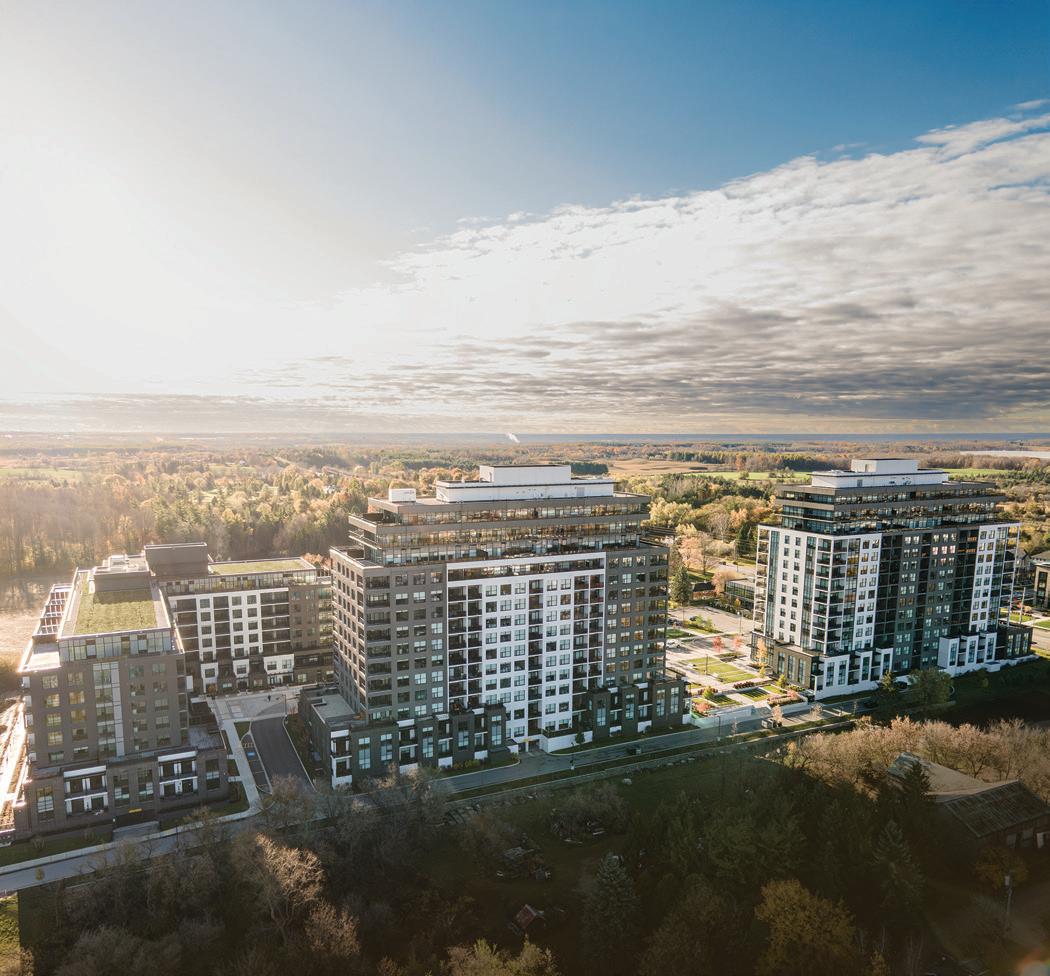


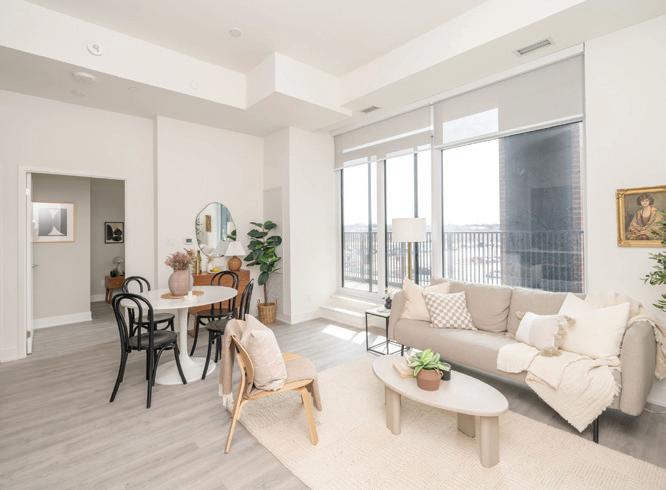


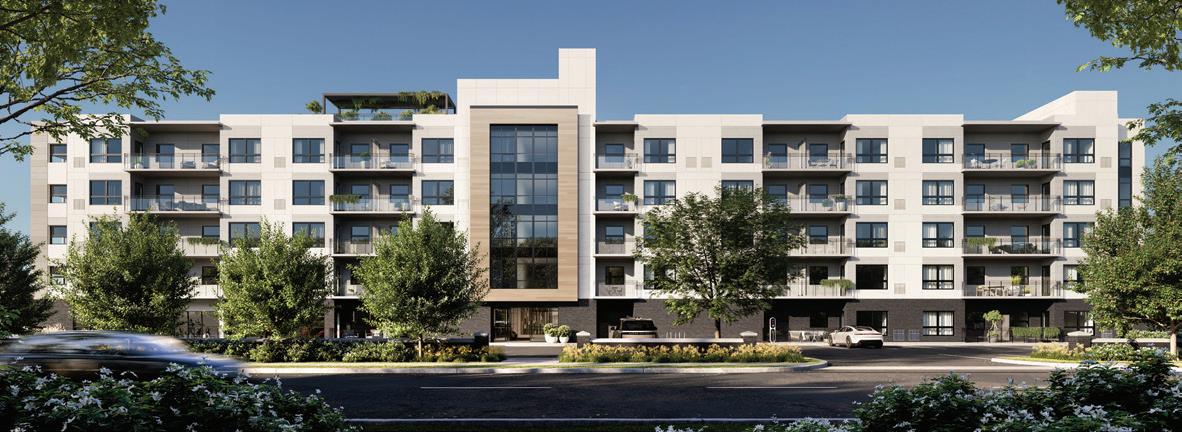

















































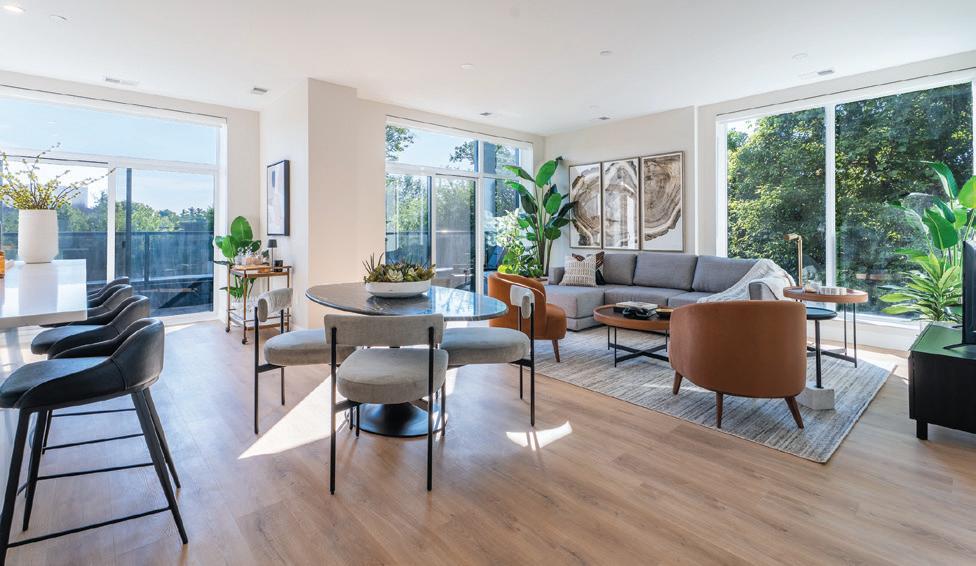




























































WAYNE KARL EDITOR-IN-CHIEF Condo Life
EMAIL: wayne.karl@nexthome.ca
TWITTER: @WayneKarl
The federal government’s much anticipated recently released Budget 2025 held such promise – and we certainly hoped – that it would address the issues facing the housing markets in Canada.
Indeed, homebuilding and other housing stakeholders, including the Canadian Home Builders’ Association (CHBA), had been educating Ottawa in recent months on the issues, and offering potential solutions.
It is a “plan to transform our economy from one that is reliant on a single trade partner, to one that is stronger, more self-sufficient and more resilient to global shocks,” the government says. “Our plan builds on Canada’s strengths – world-class industries, skilled and talented workers, diverse trade partnerships, and a strong domestic market where Canadians can be our own best customers. We are creating an economy by Canadians, for Canadians.”
Be it due to a focus on a larger, more fundamental economic pivot to deal with increasing trade challenges, early reviews are that Ottawa came up short on the housing component in Budget 2025.
CHBA, the Ontario Home Builders’ Association (OHBA), and the Building Industry and Land Development Association (BILD) all seem less than enthralled with inclusions in the budget to address housing challenges with any immediacy.
Some good news, however, comes from the province, with its Fall Economic Statement.
Like CHBA and BILD, OHBA says it will continue to advocate for the removal of the provincial portion of the GST on all new home construction, not just for first-time homebuyers – which represent only about five per cent of the new home market.
Meanwhile, as our story on page 18 and other content in this issue explores, there are new-home buying opportunities in the GTA and elsewhere in Ontario – for those who are well prepared and can budget accordingly.














An award-winning interior designer, Mariam Aboutaam is Director, Sales and Marketing, Interior Design at Kylemore, Markham, Ont., a builder known for master-planned communities and luxury homes. kylemoreliving.com.
Jesse Abrams is Co-Founder at Homewise, a mortgage advisory and brokerage firm based in Toronto. thinkhomewise.com
Elechia Barry-Sproule is President of the Toronto Regional Real Estate Board (TRREB) and Broker/Owner of Red Apple Real Estate Inc. She is committed to mentoring and supporting real estate professionals across the industry. trreb.ca.
Mike Collins-Williams, RPP, MCIP, is CEO West End Home Builders’ Association. westendhba.ca.
Debbie Cosic is CEO and founder of In2ition Realty. She has overseen the sale of more than $15 billion worth of real estate. With Debbie at its helm, In2ition has become one of the fastest-growing and most innovative new home and condo sales companies. in2ition.ca
Barbara Lawlor is CEO of Baker Real Estate Inc. A member of the Baker team since 1993, she oversees the marketing and sales of new home and condominium developments in the GTA, Vancouver, Calgary and Montreal, and internationally in Shanghai. baker-re.com
Linda Mazur is an award-winning, nationally publicized designer and Principal of Linda Mazur Design Group. With almost two decades of experience this in demand multi-disciplinary design firm is known for creating relaxed, stylish spaces and full-scale design builds within Toronto, the GTA and throughout Canada. lindamazurdesign.com @LindaMazurGroup
Ben Myers is the President of Bullpen Consulting, a boutique residential real estate advisory firm specializing in condominium and rental apartment market studies, forecasts and valuations for developers, lenders and land owners. Contact him at bullpenconsulting.ca and @benmyers29 on Twitter.
Dave Wilkes is president and CEO of the Building Industry and Land Development Association (BILD), the voice of the home building, land development and professional renovation industry in the GTA. For the latest industry news and new home data, follow BILD on Twitter at @bildgta or visit bildgta.ca
SENIOR VICE-PRESIDENT, SALES, NEXTHOME
Hope McLarnon 416.708.7987 hope.mclarnon@nexthome.ca
SENIOR MEDIA CONSULTANT
Amanda Bell 416.830.2911 amanda.bell@nexthome.ca
EDITORIAL DIRECTOR
Amanda Pereira
EDITOR-IN-CHIEF – GREATER TORONTO AREA
Wayne Karl wayne.karl@nexthome.ca
CONTRIBUTORS
Mariam Aboutaam, Jesse Abrams, Elechia Barry-Sproule, Mike Collins-Williams, Debbie Cosic, Barbara Lawlor, Linda Mazur, Ben Myers, Dave Wilkes
EXECUTIVE MEDIA CONSULTANTS
Jacky Hill, Michael Rosset
VICE-PRESIDENT, MARKETING – GTA
Leanne Speers
MANAGER CUSTOMER SALES/SERVICE
Marilyn Watling
SALES & MARKETING CO-ORDINATOR
Gary Chilvers
BUSINESS DEVELOPMENT MANAGER
Josh Rosset
DISTRIBUTION distributionteam@nexthome.ca
ACCOUNTING INQUIRIES
accountingteam@nexthome.ca
DIRECTOR OF PRINT MEDIA
Lauren Reid–Sachs
VICE-PRESIDENT, PRODUCTION – GTA Lisa Kelly
PRODUCTION MANAGER – GTA Yvonne Poon
GRAPHIC DESIGNER & PRE-PRESS COORDINATOR
Hannah Yarkony

Published by nexthome.ca
Advertising Call 1.866.532.2588 ext. 1 for rates and information. Fax: 1.888.861.5038
Circulation Highly targeted, free distribution network aimed at real estate buyers using street level boxes, racking and Toronto Star in-home delivery.
Canadian subscriptions 1 year = 13 issues – $70 (inc. HST). Canada Post – Canadian Publications Mail Sales Product Agreement 40065416.
Copyright 2025 All rights reserved. All copyright and other intellectual property rights in the contents hereof are the property of NextHome, and not that of the individual client. The customer has purchased the right of reproduction in NextHome and does not have the right to reproduce the ad or photo in any other place or publication without the previous written consent of NextHome.
Editorial Submissions from interested parties will be considered. Please submit to the editor at editorial@nexthome.ca.
Terms and Indemnification Advertisers and contributors: NextHome is not responsible for typographical errors, mistakes, or misprints. By approving your content and/ or submitting content for circulation, advertisers and contributors agree to indemnify and hold harmless NextHome and its parent company from any claims, liabilities, losses, and expenses (including legal fees) arising out of or in connection with the content provided, including but not limited to any claims of copyright infringement, unauthorized reproduction, or inaccuracies in the content. Advertisers acknowledge that they have the necessary rights, permissions, and licenses to provide the content for circulation, and they bear full responsibility for the content’s accuracy, legality, and compliance with applicable laws upon approval. Contributors acknowledge NextHome reserves the right to omit and modify their submissions at the publisher’s discretion.
With a goal to address the issues Canada faces with regard to a rapidly changing and increasing trade and economic uncertainty, Budget 2025 was intended to focus on things the federal government can control.
Budget 2025: Canada Strong was to be “our plan to transform our economy from one that is reliant on a single trade partner, to one that is stronger, more self-sufficient and more resilient to global shocks. Our plan builds on Canada’s strengths – world-class industries, skilled and talented workers, diverse trade partnerships, and a strong domestic market where Canadians can be our own best customers. We are creating an economy by Canadians, for Canadians.”
Budget 2025 delivers on the government’s Comprehensive Expenditure Review to modernise government, improve efficiencies and deliver better results and services for Canadians. It includes a total of $60 billion in savings and revenues over five years, and makes generational investments in housing, infrastructure, defence, productivity and competitiveness. These are the smart, strategic investments that will enable $1 trillion in total investments over the next five years through smarter public spending and stronger capital investment.
Despites such promise, housing industry sources say Budget 2025 comes up short in addressing the issues facing the homebuilding industry in Canada.
Nationally, Canadian Homes Builders’ Association (CHBA) is raising concerns regarding the excessive expectation being placed on initiatives for government-supported housing through Build Canada Homes – an initiative that will help homelessness and low-income households needing support, but not address homeownership for the middle class of the next generation.
Despite urgent calls for action, the budget presented no new measures to address housing affordability for the average Canadian who still wants to become a homeowner, CHBA says. It emphasized the promise of a GST exemption for first-time buyers – a measure announced earlier and still not legislated, which has left buyers on the sidelines and stalled new construction.
CHBA also the budget missed an opportunity to expand the GST relief to all buyers of new homes, and to renovations that create added housing units, such as additional dwelling units (ADUs) or secondary suites.
At the provincial level, The Ontario Home Builders Association (OHBA) says it is deeply disappointed with the lack of support for Ontario’s homebuilders and buyers. The budget presented no new measures to unlock supply and restore affordability, as Housing Minister Gregor Robertson previously indicated, and the federal approach remains focused on incremental change rather than transformative action. OHBA says there is no new measures to support the construction of market housing – the segment where most Ontarians seek to buy or rent homes.
And more locally, the Large Urban Centre Alliance, co-facilitated by the Building Industry and Land Development Association (BILD), says it is concerned with the budget’s response to the serious issues impacting the housing sector in Canada’s largest municipalities.
Budget 2025 acknowledges the affordability challenges in new home construction by confirming an increase to the GST/HST rebate thresholds to the first $1 million, with a declining rebate to $1.5 million, but only for first-time buyers – a very small fraction of the market, BILD says.
While there is an allocation of $12 billion over 10 years to housing
enabling infrastructure, Budget 2025’s treatment of development charges (DCs) is particularly troubling. Not only has the federal government’s language changed markedly, backing away from the commitment to reduce DCs by 50 per cent, but the commitment is now only a framework for federal, territorial and provincial agreements, not an actionable plan to reduce municipal housing fees with any sense of urgency.
Says David Wilkes, president and CEO of BILD and co-facilitator of the Large Urban Centre Alliance: “Not only is the budget based on old data, but its commitments are centred on a reduced Build Canada Homes and vague language on a diluted framework to eventually reduce DCs following successful negotiations with provinces and ultimately municipalities – and the industry is left wondering: How long will that take?”
The Alliance continues to call on the federal government to recognize the magnitude of the crisis and reiterates the need to:
• Treat all Canadians fairly and extend the GST/HST exemption for all newhome buyers
• Keep the election promise to reduce municipal DCs by 50 per cent
• Honour its commitment to bring forward a Multi-Unit Residential Building tax incentive program
Amexon Development Corp. is celebrating three wins for Missoni Sky, earning international recognition in Paris, London and Toronto for its design excellence.
Missoni Sky was recently named Best Presentation Centre at the 2025 Ontario Home Builders’ Association (OHBA) Awards of Distinction.
At the DNA Paris Design Awards 2025, the Missoni Sky Presentation Gallery, designed by II BY IV DESIGN, won for Interior Design. In London, Missoni Sky was also recently honoured at the 2025 Society of British & International Interior Design Awards, winning the Best of Region award.

“We are thrilled to receive these three awards,” says Ashling Evans, general manager of Real Estate Development at Amexon Development. “They all acknowledged our shared vision with Missoni to
create spaces that truly embody the Missoni spirit. It’s gratifying to see this recognized by the international industry at large.”
missonisky.com
Home sales in the Greater Toronto Area (GTA) were down year-over-year in October, while new listings were up, according to the latest statistics from the Toronto Regional Real Estate Board (TRREB). Market conditions continued to favour homebuyers, as average selling prices were negotiated down alongside lower mortgage rates.
“Buyers who are confident in their employment situation and ability to make their mortgage payments over the long term are benefitting from affordable housing market conditions relative to the past few years,” says
TRREB President Elechia BarrySproule. “However, many intending homebuyers remain on the sidelines due to uncertainty about their economic future.”
GTA realtors reported 6,138 home sales through TRREB’s MLS System in October 2025 – down by 9.5 per cent compared to October 2024. New listings amounted to 16,069 – up by 2.7 per cent year-over-year.
On a seasonally adjusted basis, October home sales were down month-over-month compared to September 2025. New listings were also down compared to September.
The MLS Home Price Index (MLS HPI) Composite benchmark was down by five per cent year-overyear in October 2025. The average selling price, at $1.05 million, was also down by 7.2 per cent compared to October 2024.
On a month-over-month seasonally adjusted basis, the MLS HPI Composite was essentially flat compared to September. The average selling price was down compared to September.
“The monthly mortgage payment for an average-priced GTA home continued to trend lower in October, benefitting from both lower borrowing costs and lower selling prices,” says TRREB Chief Information Officer Jason Mercer. “This means more buyers can now afford to purchase a home that meets their housing needs. Once we have more certainty on the economic front, including trade with the U.S. and China, home sales should increase.”
“Housing is essential economic infrastructure,” adds TRREB CEO John DiMichele. “As the population continues to grow, innovation and private capital are required to accelerate new construction across all housing types. Governments can help by modernizing tax rules, cutting buyer costs and ending exclusionary zoning. Working together, we can rebuild confidence, create jobs, and deliver the homes Ontarians need. We have to act now.”
As part of its plan to lower costs and help more families realize the dream of homeownership, the Ontario government is proposing to rebate the full eight-per-cent provincial portion of the HST for first-time homebuyers on new homes valued up to $1 million. The move is universally lauded by the homebuilding industry.
The province’s proposal, included in the 2025 Fall Economic Statement, would save first-time homebuyers up to $80,000 off the cost of a new home when combined with existing provincial relief, helping lower costs for first-time buyers and spurring the construction of more homes. When combined with the federal government’s proposed removal of its five-per-cent portion of the HST, which would save up to $50,000 off the cost of a new home, total savings for first-time buyers would equal up to $130,000.
“In the face of tariffs and global economic uncertainty, it’s never been more important to make life more affordable for the hardworking people of Ontario,” says Peter Bethlenfalvy, minister of finance. “Through our proposed HST rebate on new homes for qualifying first-time homebuyers, we are leading by example – saving families money on one of the biggest financial transactions of their lives.”
“The Ontario government’s extension of the GST/HST exemption to the first $1 million on the purchase of a new home, or substantially renovated home, for first-time homebuyers is a step in the right direction in addressing the worst housing downturn on record,” says Dave Wilkes, president and CEO of the Building Industry and Land Development Association (BILD). “Addressing this challenge requires the concerted effort of all levels of government and the industry to lower new housing costs, increase housing starts and protect jobs and the economy. (BILD) appreciates the efforts of the provincial government and will continue to work with the government to advise on additional measures required to address the structural challenges facing the industry. With GTA new housing prices down 20 per cent from the peak and these new measures, now is a great time for first-time buyers to step off the sidelines and get into the market.”
“RESCON has been advocating for an aligned GST/HST rebate for first-time homebuyers,” adds Richard Lyall, president of the Residential Construction Council of Ontario (RESCON). “We are grateful to the provincial government for their announcement which implements

this full GST/HST rebate of 13 per cent for first-time homebuyers in Ontario. This is good news for the thousands of young people and families who have been struggling to realize the dream of new-home ownership.”
The new Ontario rebate would be available in addition to the existing Ontario HST New Housing Rebate, which already provides relief of up to $24,000 to eligible purchasers, including but not limited to firsttime home buyers. Together with Ontario’s existing HST New Housing Rebate, the new Ontario rebate would provide relief of the full eight-per-cent provincial portion of the HST on qualifying new homes valued up to $1 million for first-time homebuyers. For homes valued between $1 million and $1.5 million, the new rebate would follow the phased reduction under the proposed federal rebate. That means the rebate would be gradually reduced as the price of a new home increases from $1 million to $1.5 million, to a minimum of $24,000 for homes valued between $1.35 million and $1.5 million. This ensures the combined amount of relief available under both Ontario rebates would not be less than the amount that is currently provided through the existing Ontario HST New Housing Rebate.
The Ontario Home Builders’ Association (OHBA) says it is pleased with the provincial government’s 2025 Fall Economic Statement, though it doesn’t introduce new policy initiatives to address housing challenges.
“We are encouraged that opportunities may still exist for the government to implement muchneeded measures due to tariffs and other economic challenges to stimulate the Ontario home construction industry and keep over 40,000 workers employed,” OHBA says.
The government is projecting deficits of $13.5 billion in 2025-26 and $7.8 billion in 2026-27, followed by a surplus of $0.2 billion in 2027-28.
The net debt-to-GDP ratio is projected to be 37.7 per cent in 202526, slightly lower than the forecasted 37.9 per cent from the 2025 Budget. This ratio fell to a 13-year low last year. The net interest as a percentage of operating revenue ratio for 202526 is forecast to be 6.4 per cent and remains close to the lowest levels it has been at since the 1980s.
Ontario’s real GDP growth has been impacted by U.S. trade policy and tariffs and is projected to decelerate from 1.4 per cent in 2024 to 0.8 per cent in 2025 and 0.9 per cent in 2026, in line with the projections at the time of the 2025 Budget. Real GDP growth is expected

to pick up in subsequent years with projected increases of 1.8 per cent in 2027 and 1.9 per cent in 2028.
“It is heartening to see the additional funding of $50 million for the Better Jobs Ontario program,” OHBA says. “This program supports skills training to help job seekers train and upskill for in-demand positions. We recognize the importance of our skilled labourers, and that without additional support, Ontario was looking at losing up to 40,000 skilled trades jobs. This is an important measure to support our members and tradespeople across Ontario.”

The Minister of Finance reaffirmed the Ontario government’s commitment to remove the eight per cent provincial sales tax for firsttime buyers on new homes valued up to $1 million, pending the passing of federal legislation. With the ratio of net debt to GDP falling to a 13year low, this will free up surplus revenues that can be diverted to priority projects, OHBA says. “We firmly believe that taking decisive action to address the housing crisis and to restart home construction
in Ontario must be one of these priorities.
With that in mind, OHBA says it will continue to advocate for the removal of the provincial portion of the GST on ALL new home construction, not just for first-time homebuyers. According to research conducted by OHBA, first-time buyers currently represent approximately five per cent of the new home market. It will take bold action by all levels of government to unlock supply and restore affordability. “We will continue to call on the government of Ontario to lead by taking bold action that will make homeownership a reality for younger generations.
“We anticipate that the next few years will be marked by uncertainty and low economic growth. Consumers are not making the largest purchase of their lives if they aren’t certain of the future. OHBA remains committed to continuing to lobby the provincial government to expand this PST relief for all new-home sales in Ontario, and spur both the purchase and ongoing construction of new homes across the province.”

How to get the best mortgage when it’s time to renew
Over the next two years, millions of Canadians will reach mortgage renewal. Unlike past renewal cycles, this one comes at a time when interest rates are still elevated compared to historic lows. But with preparation, the renewal process can also be a valuable opportunity to save money and secure a mortgage that better suits your needs today.
GTA builders shine at 2025 OHBA Awards of Distinction
The Ontario Home Builders’ Association has announced the winners of the 2025 OHBA Awards of Distinction, with builders in the GTA and surrounding area taking home several key awards.

First-timers cautious as market primed for buyers
Declining interest rates, higher inventory levels and softening home prices in major cities are opening new doors for first-time buyers in 2025. Many are carefully planning their newhome purchases, according to a recent survey from Royal LePage.

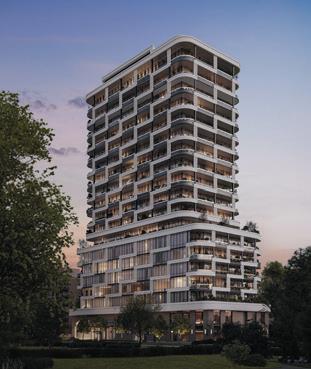
Timeless. By design. At 429 Walmer by Stafford Homes
Set in one of Toronto’s most storied neighbourhoods are 48 private residences shaped by timeless architecture and quiet intent. Welcome to 429 Walmer by Stafford Homes, an 18-storey condominium in two- and three-bedroom layouts and beyond, offering an unprecedented standard of luxury in Forest Hill Village.

GTA housing dynamics: A cycle about to turn?
The GTA housing market in late 2025 is offering opportunities for buyers willing to take measured risks. After years of explosive growth, we have entered a correction phase, but strong long-term fundamentals remain: Limited land, high demand and a diverse population that still needs housing. For many, today’s lull may represent a brief pause before the next climb.
Visit nexthome.ca


On Oct. 23, Ontario took another important step toward tackling the housing crisis and strengthening the provincial economy. Rob Flack, minister of municipal affairs and housing, introduced Bill 60, the Fighting Delays, Building Faster Act, 2025 – an omnibus bill aimed at cutting red tape, speeding up housing approvals and supporting the construction of the homes and infrastructure Ontario urgently needs.
This legislation builds on the momentum of Bill 17, the Protect Ontario by Building Faster and Smarter Act, 2025, introduced earlier this year, and represents a direct response to the challenges faced by the building and development industry across the province. It is also a clear recognition by the provincial government that housing supply and affordability depend on an efficient regulatory environment, timely approvals and fair, transparent cost structures.
At its core, the new act protects Ontario’s economy by keeping workers on the job and getting shovels in the ground faster. It reflects the need to lower the cost to build, reduce bureaucratic delays and improve infrastructure planning and delivery.
Bill 60 focuses on several priorities, including:
Accelerating development near transit-oriented communities, helping to bring more homes, businesses and
amenities closer to where people live and work while maximizing the investment made in transit infrastructure.
Establishing a Peel water and wastewater corporation as a potential new model for how these services are provided in Ontario. This builds on key learning from other jurisdictions that fund water and wastewater in a different way, enabling the infrastructure while not inflating the cost of new homes. If successful, this will be a critical step in finding new ways to fund growth more sustainably by launching a review of the Ontario Building Code to discover and eliminate additional unnecessary regulatory barriers that add costs.
It will clarify which minor variances might qualify as as-of-right, simplifying approvals for small, low-impact projects and certainly making life simpler for homeowners looking to add a deck or add a small addition.
It will consult on reforms to streamline official plans, municipal application processes and Green standards as they relate to site plan control – addressing issues that result in costly delays or directly add construction costs. Furthermore, the act takes large steps to modernize development charges (DCs), which remain one of the largest and most onerous costs in new home construction. Specifically, regarding DCs, it will:
Provide clear direction on how to calculate who pays for what – newhome buyers or the existing tax base –based on who benefits the most.
It will require municipalities to develop local service policies –
policies that identify which costs in a new development are the obligation of the new development or the municipality.
Provide direction on how DCs are calculated to remove some elements that have distorted DCs levels in higher cost municipalities.
These measures will bring much-needed transparency and accountability to the system, ensuring that municipalities have the funds required to support growth, while preventing homebuyers from being unfairly burdened by inconsistent or inflated municipal fees.
The Fighting Delays, Building Faster Act, 2025 reinforces the Ontario government’s commitment to working with municipalities and the building industry to deliver more homes, faster. By modernizing approvals, reforming development charges and aligning infrastructure planning with growth, this legislation advances a pragmatic, solutions-oriented approach to housing policy. Ontario’s housing crisis is not insurmountable, but it requires focus, urgency and cooperation. The Fighting Delays, Building Faster Act, 2025 embodies all three.
Dave Wilkes is President and CEO of the Building Industry and Land Development Association (BILD), the voice of the homebuilding, land development and professional renovation industry in the GTA. For the latest industry news and new home data, follow BILD on Twitter, @bildgta or visit bildgta.ca.





NEED TO KNOW GOING INTO 2026

If you’re a first-time buyer looking at the new condo market, you’ve probably noticed two things: Prices are no longer climbing and headlines keep warning of a “record-low sales.” But does this mean you should avoid buying, or could it be a rare window of opportunity?
On Episode 94 of the Toronto Under Construction podcast, I sat down with three of the GTA’s most influential real estate sales and marketing leaders: Andy Brethour (PMA Brethour Realty), Riz Dhanji (RAD Marketing) and Debbie Cosic (In2ition Realty). During our chat, we tried to make sense of today’s correction and what it means for buyers.
A recent report from Canada Mortgage and Housing Corp. (CMHC) compared today’s slowdown to the early 1990s, when condo prices fell sharply and projects stalled city-wide. Andy Brethour, who has lived through five previous market cycles, says the two periods feel similar, but not identical.
In the 1990s, all parts of the market collapsed at once. This time, resale condos have held up surprisingly well, even as pre-construction sales have stalled. “We’ll likely see another small price decline (maybe five to seven per cent), but there’s a light at the end of the tunnel,” Brethour says, predicting momentum will return by spring 2026.
His biggest concern? Taxes and government fees, which have exploded since the 1990s and now make up more than 30 per cent of the cost of a new home. “We’ve gone tax crazy,” he warns.
Much of today’s slowdown comes from the investor pullback. During the boom years, investors bought most new condo units. But as interest rates
surged and rents failed to keep up, the math fell apart.
Riz Dhanji says that right now, buying pre-construction for investment doesn’t pencil out. Developers would need to launch far below current pricing to make investor returns viable again, and few can afford to do so. That’s why some have cancelled or delayed launches until 2026 or 2027.
But here’s the opportunity: With investors largely sidelined, the market has shifted toward end users.
“We’re getting back to what the market actually needs,” Brethour says. “Smaller, midrise projects, and more purpose-built rentals.”
Debbie Cosic adds another key point: Yes, some price lists still show $1,800 per-sq.-ft., but real deals today are happening closer to $1,300. Prices have already corrected 10 to 40 per cent across the province.
Cosic offered a dose of realism for prospective buyers: “We’re not in an oversupply crisis, we’re in an affordability crisis.” Mortgage rates, fees, qualifying hurdles and taxes are the biggest barriers.
She argues for longer amortizations, lower development charges and more flexible financing. “A client of ours just got a 20-percent mortgage rate. That should be illegal,” she says.
Dhanji adds that Canada is the only country that bans foreign buyers from purchasing pre-construction condos, which he believes is hurting supply and slowing recovery. Australia, by contrast, encourages foreign buyers in new builds but blocks them from resale, keeping locals competitive while still funding construction.
You’ve probably seen articles claiming condos are “too small to live in.” The panel pushed back strongly.
“A well-designed 500-sq.-ft. unit absolutely works,” Cosic says. For many first-time buyers, a compact, efficient unit is the only viable entry point into homeownership, especially without parental help.
Dhanji agrees that some units are “unlivable,” but insists the problem
isn’t size, it’s cost. Reduce red tape, and builders can make slightly larger suites without pushing prices out of reach.
Brethour goes further, calling the federal government’s $13-billion housing pledge “irresponsible” for ignoring the role of market housing entirely. He cites Munich’s 2008 solution: The City purchased unsold inventory and turned it into rentals. Toronto could do the same today, instantly unlocking 21,000 new units.
The panel is clear: This market still carries risk, but also real opportunity.
Prices are down. Investors aren’t competing with you. Sales cycles are longer and more negotiable. Developers are offering incentives unheard of during the boom. And if rates drop again in 2026, the prices developers need to generate a profit could work for buyers again.
As Dhanji says, “We’re not doing 400 units in a weekend anymore. It’s a 24-month grind.” Translation: You have time to do homework, compare projects and negotiate.
The market isn’t broken, but the old playbook is. Quick flips, 10-per-cent deposits and blind bidding wars are gone. What remains is a slower, more cautious, more end-user-focused condo market.
For those who buy thoughtfully, in the right locations, with realistic timelines and strong builders, will not regret their decision to buy. Surround yourself with an experienced team, do your own research, and buy what you can afford. Good luck. +MORE CONTENT ONLINE nexthome.ca
Ben Myers is the President of Bullpen Consulting, a boutique residential real estate advisory firm specializing in condominium and rental apartment market studies, forecasts and valuations for developers, lenders and land owners. Contact him at bullpenconsulting.ca and @benmyers29 on Twitter.
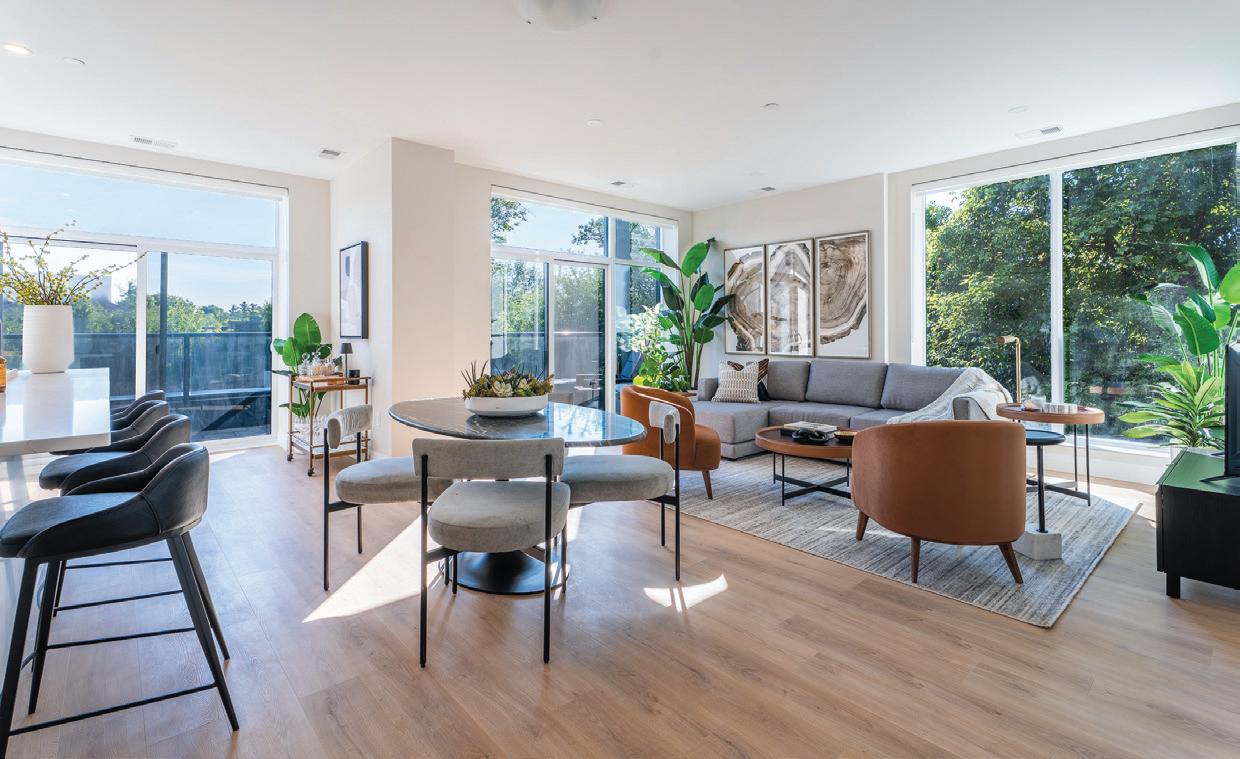
MORE AFFORDABLE )
It’s not often that prospective buyers of new construction condominiums can see exactly what they’re getting. The process usually involves renderings, architectural scale models and perhaps a single model suite that can be toured. However, Guelph builder The Tricar Group is changing all of that, with an innovative approach that turns the old way of doing business on its head.
The company successfully launches sales of new condominium homes after the building is complete – an approach that has proven effective time and time again, even in today’s evolving market.
“At Tricar, an exceptional customer experience is at the forefront of everything we do,” says Tricar’s President Adam Carapella. “We are committed to delivering certainty and quality to homebuyers. By building Gordon Square III without a pre-sales phase, we’re not only accelerating the delivery of much-needed housing, we are giving buyers peace of mind. They can walk through the finished suites, move in quickly and avoid the uncertainty of waiting years for a home. It’s a smarter, more reliable way to buy, focused on the needs of homeowners.”
Gordon Square III is the final phase of the builder’s popular Guelph
development, and it reflects a savvy way to buy new construction condos. The condominium residence is an eight-storey midrise with 181 units, built on spec and substantially complete.
Tricar’s suites are significantly larger than those typically offered on the market. Their premier condominium homes are designed to be spacious and are constructed with high quality. (For example, the two-bedroom suites range from 1,100 to 1,600 sq. ft.) The result is that buyers are responding, because Gordon Square III offered homes at the size people desire.
As the GTA is expanding westward, many current Toronto residents are


looking at communities such as Guelph for homeownership, where prices are still attainable, amenities are abundant and most parts of the GTA are less than a 30-minute drive or GO train ride away.
Based on the success of Gordon Square Phases I and II, Tricar had the confidence to undertake building Gordon Square III without pre-selling any suites.
1. Eliminates risk due to lengthy construction timelines. Prospective new-home owners can purchase with confidence and certainty, without needing to speculate on changing interest rates and housing prices years before the project’s completion. Anyone with a home to sell can buy and sell in the same market conditions and are not vulnerable to fluctuations.
2. The pricing for end users and firsttime home buyers is attainable. Tricar is a vertically integrated builder/ developer and has developed a platform to deliver a project price that is much more affordable than the general marketplace.
Current pricing is approximately $518 per sq. ft. for a two-bedroom suite and $628 per sq. ft. for a onebedroom suite. Sale price for a twobedroom is approximately $594,000 (based on a 1,146-sq.-ft. model), and a one-bedroom suite will be approximately $478,000 (based on a 761-sq.-ft. model).

These prices are about 50 per cent less than the cost of the average price for a similar condominium in some of the surrounding regions and offer excellent value. “Tricar isn’t just the developer, we are the builder,” says Craig Taylor, Tricar’s vice-president of design and marketing. “As a result, we are able to control all aspects of the development and construction process and provide a top-quality home at an incredibly attractive price.”
3. Realistic deposit structures. Lenders require larger deposits on the pre-sale construction because of perceived risk. However, now that Gordon Square III is built, risk is minimized, and smaller deposits can be accepted to buy your home.
The Tricar Group requires only a $40,000 deposit and offers a first-time homebuyer special of only $20,000. Comparatively, the industry standard for a typical deposit structure for a new pre-sale condominium is 20 per cent. Based on average sales prices, this can easily generate a deposit amount of more than $100,000.
Tricar prides itself on the quality of its construction and customer
service, controlling all stages of the development, construction, and delivery process. The company is one of the province’s most trusted highrise builders, a leading condominium and market rental developer across southwestern Ontario. They are also a nine-time Tarion Top Performer and a multiple award winner of Tarion’s Highrise Builder of the Year.
Not everyone is in a position to wait and see how the market shifts. For those who are looking to buy and still want to buy a new home, there are still excellent opportunities out there. Gordon Square III is the final phase in this landmark community. It is now completed and has started sales.
The sales centre and model suites are now open. In addition to all the model suites, visitors can also experience the completed extensive amenity spaces at Gordon Square III. Visit tricar.com or call 519.652.8900 to learn more about Gordon Square III. You can also follow on Facebook, X, YouTube and Instagram at @the_tricar_group.
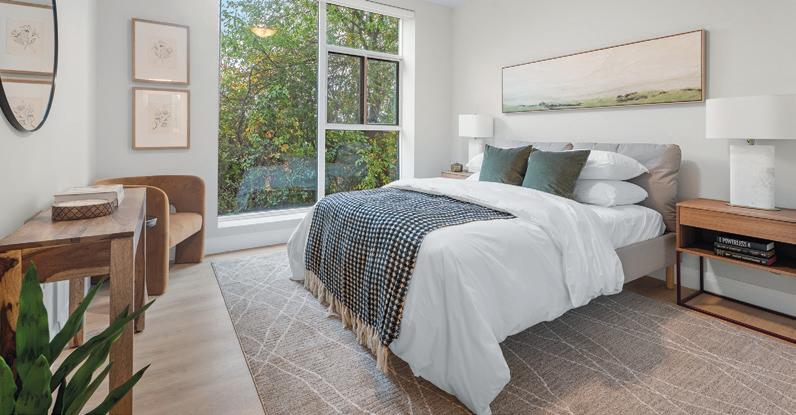

As we round the fall months heading into the end of the year, with Bank of Canada interest rate reduction in September and another expected on Oct. 29, prospective homebuyers on the new homes and resale fronts are wondering – is now the time to execute their well-thought-out plans.
Uncertainty from the threat of U.S. tariffs remains, though, causing some buyers and builders to pause.
by WAYNE KARL
If there was pent-up demand before, these circumstances are only causing it to grow even further, as prospective buyers wait for clarity before making their move.
“The Greater Toronto Area housing market in late 2025 is offering opportunities for buyers willing to take measured risks,” industry consultant and analyst Ben Myers says in his Stat Chat column on page 20.
“After years of explosive growth, the market has entered a correction phase. Some of the long-standing drivers of price appreciation have reversed: Population growth has slowed, sales have stalled and even the rental market has cooled. Yet beneath these short-term adjustments, the same fundamentals remain: Limited land, strong long-term demand and a diverse


population that still needs housing. For many, today’s lull may represent a brief pause before the next climb.”
Indeed, currently, it’s a buyers’ market, and there are choices and deals, particularly for inventory homes that are ready to move in.
“Our move-in ready homes are moving fast in this buyers’ market,” Richard Mariani, says sales and marketing manager at CountryWide Homes. “Homebuyers see the unique opportunity to be able to get into a brand-new CountryWide home that comes with appliances, air conditioner, full warranty, zero development charges and thousands of dollars in upgraded finishes.
“Whether they’re looking for a freehold townhome, semi or detached home, there’s flexibility to move in before the holidays or early 2026 in some of our most indemand and premium communities throughout the GTA.”
CountryWide, of course, is not the only builder with such offerings.
One company, The Tricar Group, is taking move-in ready to another level with an innovative approach. The company is launching sales of new condominium homes – after the building is complete (see page 16).
“By building Gordon Square III without a pre-sales phase, we’re not only accelerating the delivery of much-needed housing, we are giving buyers peace of mind,” says Tricar’s President Adam Carapella. “They can walk through the finished suites, move in quickly and avoid
the uncertainty of waiting years for a home. It’s a smarter, more reliable way to buy, focused on the needs of homeowners.”
Another builder, Terra View Homes, has Designer Series Homes of “movein ready, quick occupancy, quality family homes. Comprised of our most sought-after and in demand floorplans, every Designer Series home is finished in today’s most trending designer finishes both inside and out.”
Branthaven offers a series of Quick Start Homes that are move-in ready, with 30- to 120-day closings. These may also include luxury upgrades and more than $500,000 in price reductions.
National Homes, too, is offering significant enticements at some of its developments, including $200,000 cash off and a bonus value at its Northshore Townhomes community in Burlington.
“While some might see the uncertainty as a reason to wait, savvy buyers know that these conditions create opportunities to secure fantastic pre-construction deals,” says Debbie Cosic, CEO and founder of In2ition Realty. “Developers are offering incentives to attract buyers, and those who act now can lock in incredible value before the market shifts again.”
Some builders are also offering appealing incentives to buy sooner than later. These vary from builder to builder, however, and are sometimes shared with buyers only in sales
BRAMPTON Queens Lane by Branthaven branthaven.com
BURLINGTON
Millcroft Towns by Branthaven branthaven.com
GUELPH Gordon Square III by The Tricar Group tricar.com
GUELPH Hart Village by Terra View Homes terra-view.com
GUELPH Nima Trails by Terra View Homes terra-view.com
MARKHAM Gallery Towers by The Remington Group downtownmarkham.ca
OAKVILLE West & Post by Branthaven branthaven.com
OAKVILLE Upper West Side 2 by Branthaven branthaven.com
offices. They are also available for the proverbial “limited time only and subject to change without notice,” so it’s best to check with builders directly.
CountryWide, for example, had earlier partnered with TD Bank to offer firm mortgage approvals up to 24 months. Another company was recently offering a new car with home purchase.
Another builder, The Remington Group, is offering a free car or $85,000 in cash value, at its Gallery Towers development in downtown Markham.

The reasons to buy a new, preconstruction house or condominium – especially for first-time buyers – just keep increasing. Recently, Ontario proposed to remove the eight-per-cent provincial portion of the HST for first-time buyers on new homes valued at up to $1 million. This is a major step, as it will save potential purchasers looking to enter the pre-construction housing market up to $80,000, which increases to $130,000 when combined with the proposed federal rebate. If this is your first journey into homeownership, think about what that money could go toward.
Plus, it was only a few months ago that the federal government eliminated the Goods and Services Tax (GST) for first-time home buyers on new homes up to $1 million and reduced the GST for firsttime home buyers on new homes between $1 million and $1.5 million. More information on how first-time homebuyers can take advantage of government incentives and rebates is available from Canada Mortgage and Housing Corp. (cmhc-schl.gc.ca). We can hope that in the future, these steps will happen for all new home and condo purchasers, not just firsttime buyers.
There are, of course, numerous other reasons for all homebuyers to purchase new over resale, starting with our new home warranty, which provides priceless peace of mind. The seven-year warranty
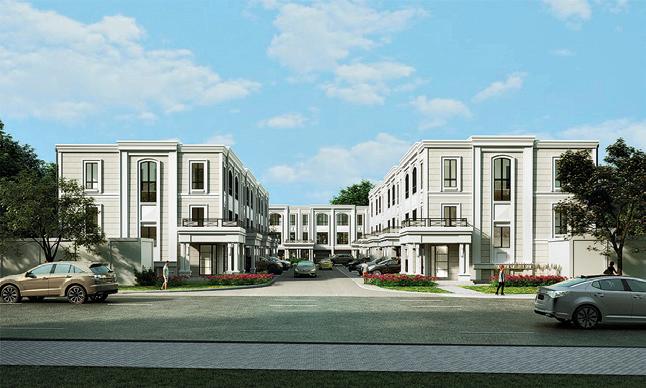
takes effect upon possession and protects major structural defects (tarion.com). Imagine how good it feels to know you have deposit protection, coverage for delayed closing/occupancy, condominium cancellations and financial loss coverage for contract houses – not to mention expensive repairs and refurbishing so often necessary with resale homes.
And speaking of peace of mind, keep in mind that the Ontario Building Code is updated regularly to keep pace with the most advanced technologies and materials. Thinking ahead, this bodes well for the value of your house or condo over time.
And speaking of condos, the perks of this type of living are exciting, with elegant amenities under your roof. No need to leave the building when there are fitness facilities, theatres, entertainment spaces and/or rooftop terraces, etc. The condominium suites of today come with chic standard features and finishes, as well as layouts that maximize every square foot.
The up to $80,000 that would normally go to the provincial portion
of the HST could be spent on highor lowrise upgrades, if you are so inclined. And if you buy early enough in the selling cycle, you will be able to select those standards and upgrades, which means your surroundings will feel like “home” from day one.
Whether you are a potential first-time homebuyer or a savvy experienced one, consider buying new soon. As soon as sales pick up – which they always do after a low cycle – prices and demand will increase as well. The signs of recovery are there. Next year, it may be difficult to find what you want at a price you can afford. Buy new and buy now.
Barbara Lawlor is CEO of Baker Real Estate Inc. A member of the Baker team since 1993, she oversees the marketing and sales of new home and condominium developments in the GTA, Vancouver, Calgary and Montreal, and internationally in Shanghai. baker-re.com
DEBBIE COSIC

As we move into the final months of 2025, reflecting on one of the toughest real estate cycles in recent decades, there’s still room for cautious optimism throughout the Canadian market. Despite ongoing uncertainty, today’s conditions present a unique opportunity for buyers and investors alike. Factors such as moderating interest rates, appealing purchase incentives and a tightening supply of new housing options are aligning to make this a strategic moment to consider investing in real estate.
Many of today’s pre-construction projects offer extended closing timelines, often four to five years for condos and up to two years for detached homes or townhomes, allowing buyers extra time to save for their deposits while locking in today’s prices. Many developers are also introducing flexible deposit structures, often requiring as little as 10 per cent in total, sometimes spread over several years in installments as low as three per cent annually. This staggered approach helps ease the upfront financial commitment, making homeownership or investment more attainable.
Another advantage is the availability of substantial discounts offered by developers. With recent market slowdowns, many projects are incentivizing buyers with

reduced prices, creating a rare opportunity to buy at a discount. Additionally, with fewer new developments breaking ground, future inventory will be limited, which could lead to a classic supply-demand imbalance and rising prices when the market regains momentum.
While historic gains in real estate may not replicate at the same speed in the near term, the potential for long-term appreciation remains strong. Real estate has consistently been a solid investment over the years, offering stability and tangible value. This trend, coupled with the current market conditions, means that those who enter the market now may benefit significantly as demand eventually outpaces supply.
For those considering buying pre-construction, this period offers a unique combination of lowering interest rates, favourable purchase terms, and in today’s market an abundance of inventory to choose from. In2ition Realty offers a diverse
portfolio of projects across the GTA, each designed to match these ideal conditions. Whether you’re looking for a first home, a strategic investment, or a luxury property, our range of options caters to various needs and budgets.
This is your window of opportunity. This is your chance to secure today’s value before the next market upswing and benefit from the growth ahead.
Explore these opportunities with us at in2ition.ca or follow us on social media @in2itionrealty for the latest updates.
Debbie Cosic is CEO and founder of In2ition Realty. She has overseen the sale of more than $15 billion worth of real estate. With Debbie at its helm, In2ition has become one of the fastest-growing and most innovative new home and condo sales companies. in2ition.ca
+MORE CONTENT ONLINE nexthome.ca

JESSE
ABRAMS

The Bank of Canada’s recent rate cut has led to some muted optimism across the housing market. After holding rates steady for months, the central bank trimmed its policy rate by 0.25 per cent, signaling that inflation is moving closer to its target and that borrowing costs may slowly ease ahead.
For many Canadians, this shift brings both relief and questions. Whether you’re looking to buy, renew or refinance, the impact of this change depends on where you stand.
If you’ve been waiting for signs that borrowing conditions might improve, this is one. The rate drop has already led some lenders to lower their fixed and variable mortgage rates, giving buyers a bit more room to breathe. While the difference in monthly payments might not be massive, it can make a real impact on affordability, especially for first-time buyers balancing rising home prices with tighter budgets.
Lower rates also mean slightly higher borrowing power. For example, a 0.25-per-cent cut may allow some buyers to qualify for several thousand dollars more in
purchasing capacity. That said, while home prices in many cities have been dropping, they still remain high and the stress test still requires buyers to qualify at higher benchmark rates. So, while the cut helps, it doesn’t fully solve the affordability crunch.
If you’re planning to buy soon, consider locking in a rate hold. This lets you secure today’s lower rate while giving you time to shop for a home.
RENEWALS: SOME RELIEF, BUT TIMING MATTERS
For those with mortgage renewals coming up, this rate cut brings a bit of good news, especially for anyone on a variable rate. Your payment may

decrease slightly as lenders adjust prime rates downward. If you’re on a fixed term, renewal offers might come in a touch lower than what you saw earlier this year, though still above the record-low levels we saw during the pandemic.
If your renewal is within the next year, it’s worth starting conversations early. Lenders may be more flexible in this environment, particularly if the Bank of Canada continues to ease rates over the coming months. Comparing options across lenders can help you avoid overpaying, especially if your current lender’s posted rate hasn’t yet caught up with the market. So, speak to an unbiased mortgage professional. Mortgage brokerages such as ours at Homewise provide a view of the market to let borrowers know if their current lender option is a good one or if there are better options by us shopping around. The hour or so it takes can save thousands.
For homeowners thinking about refinancing, to consolidate debt, fund renovations or invest in another property, the latest move could open new doors. Lower rates can make refinancing more attractive, as borrowing against your home becomes a bit cheaper.
Still, the decision should be made carefully. If you’re breaking an existing mortgage before its term ends, the penalty costs can be significant. The potential savings from a lower rate need to outweigh those penalties. For some, waiting until renewal to refinance might make more sense.
However, if you have high-interest debt, tapping into home equity at a lower mortgage rate can be a smart long-term play.
“
” This rate drop is a welcome sign that borrowing costs may be trending downward again.
The Bank of Canada has signaled that it will continue watching inflation and the broader economy closely. Another small rate cut later this year isn’t out of the question if price pressures keep easing. But no one expects a rapid return to the ultra-low rates of the past.
In this new environment, Canadians will likely see small,
gradual improvements rather than dramatic changes. For buyers, that means acting when the math works for your budget instead of trying to time the bottom. For those renewing or refinancing, it’s about staying informed and weighing your options early.
This rate drop is a welcome sign that borrowing costs may be trending downward again. It’s not a gamechanger, but it’s a meaningful step that offers a bit of breathing room. Whether you’re entering the market, renewing or exploring a refinance, now’s the time to review your numbers and plan your next move with a clear view of where rates and your goals stand.
Jesse Abrams is Co-Founder at Homewise, a mortgage advisory and brokerage firm. thinkhomewise.com
MIKE COLLINS-WILLIAMS

Collaboration was the name of the game at the Central Ontario Housing Summit, co-hosted by the West End Home Builders’ Association (WEHBA) and the Ontario Home Builders’ Association (OHBA) and our presenting sponsor Enbridge in early November. The event was jam packed with productive discussions and valuable insights from industry leaders, elected officials and experts across Ontario.
The day began with opening remarks from WEHBA Chair David Ionico and Presenting Sponsor, Enbridge, followed by an address from Rob Flack, minister of municipal affairs and housing. Minister Flack summed up development in Ontario in one short sentence: It takes too long and costs too much to deliver housing in Ontario. The Minister outlined actions the provincial government is taking, such as removing the provincial portion of the HST for new-home buyers purchasing homes of less than $1 million and reforming development charges. OHBA CEO Scott Andison emphasized the importance of recognizing the new home industry as a system that needs to be examined holistically to deliver better outcomes.
A Local Politics of Housing panel brought together Mayor Joe Preston
(City of St. Thomas), Councillor Maureen Wilson (City of Hamilton) and Councillor Paul Sharman (City of Burlington) for a thoughtful discussion exploring the challenges of representing their constituents, building consensus with the private sector and advancing housing supply amidst the difficult political climate.
We also heard an insightful economic overview from Derek Burleton, vice-president and deputy chief economist at TD, who predicts Canada will avoid a recession but experience lacklustre growth and a challenging 2026 and 2027 for development. Burlington Mayor Marianne Meed Ward, Chair of Ontario Big City Mayors, shared valuable municipal perspectives on housing and growth and the actions her city is taking to move development from the application pipeline to shovels in the ground, such as exploring options for a temporary elimination of local development charges.
Dr. Mike Moffatt, founding director of the Missing Middle Initiative, explored the need for ground-oriented, family-sized housing in the GTHA to prevent continued migration from the region to smaller Ontario communities. Dr. Moffat was followed by the Builders Who Survived the 1990s panel, moderated by Terri Johns (Landwise). Panelists Jeff Paikin (New Horizon Development Group), Danny Gabriele (Marz Homes) and Bob Finnigan (Heathwood Homes) shared lessons from past market
challenges and insights for surviving the current downturn and building a stronger future.
A Fireside Chat featured Paula Tenuta (BILD), Andrew Whittemore (City of Mississauga), and Arvin Prasad (City of Hamilton), offering candid discussion on the policy, planning and process improvements needed to move housing projects forward. The cultural attitude within municipal planning departments was identified as vital, with planners needing to be facilitators and not regulators.
The day was concluded remarks from Andrea Khanjin, ninister of red-tape reduction, and Christina Giannone, chair of OHBA, who summarized efforts to smooth out the process and items for future OHBA advocacy, respectively.
Together, we are taking action to break down silos and improve collaboration between municipal, federal, provincial and private stakeholders. Collaboration is necessary to improve the speed, efficiency and cost effectiveness of delivering the housing that Ontarians desperately need.
Mike Collins-Williams, RPP, MCIP, is CEO West End Home Builders’ Association. westendhba.ca.
+MORE CONTENT ONLINE nexthome.ca
ELECHIA BARRY-SPROULE

If you’re trying to buy or rent a home in Toronto, the challenge is clear: Prices remain high and supply continues to fall short. Meeting the city’s housing goals isn’t just about achieving a number, it’s about creating real options for families, first-time buyers and newcomers who want to call this region home.
In the latest episode of TRREB’s podcast, Ready to Real Estate, TRREB Chief Information Officer Jason Mercer is joined by urban planners Alex Beheshti and Graig Uens to explore how governments, builders and communities can work together to turn plans into actual places to live.
The conversation begins with the federal government’s Build Canada Homes Agency, an initiative that could accelerate construction by purchasing prefabricated homes in bulk. Prefabricated and modular homes are built faster and with less waste, at a lower cost, offering a promising way to increase supply without sacrificing quality or design.
Toronto’s recent zoning changes are another critical step forward. New permissions for multiplexes, garden suites and midrise buildings

are opening more neighbourhoods to a broader range of housing types and price points. These policies help bridge the gap between single-detached houses and highrise apartments, helping residents remain in their communities as their needs evolve.
One of the biggest challenges in building new homes: Development charges. While these fees fund essential infrastructure, they’ve risen over time, making many projects financially difficult to complete. Better alignment on funding, zoning and approvals across all three levels of government can make construction more viable and move good ideas from planning to production.
Toronto’s housing challenges won’t be solved overnight, but
collaboration, innovation and a shared sense of purpose can bring lasting progress. By focusing on practical solutions and removing unnecessary barriers, governments can help create the conditions for more homes, built faster, for the people who need them most.
To hear more insights from Alex Beheshti and Graig Uens, and to explore additional discussions on housing supply, market trends and policy, listen to Ready to Real Estate at trreb.ca.
Elechia Barry-Sproule is President of the Toronto Regional Real Estate Board (TRREB) and Broker/Owner of Red Apple Real Estate Inc. She is committed to mentoring and supporting real estate professionals across the industry. trreb.ca.
+MORE CONTENT ONLINE nexthome.ca

by LINDA MAZUR
Fireplaces add a certain charm to a home, and with cooler days ahead, it’s the perfect time for cosying up by the fire. We all want to create spaces that not only reflect our personality and style, but that are warm, inviting and relaxing… and what better way to do that than by introducing a fireplace.
If you reside in a house, adding a fireplace to your home can often be done with relative ease. However, condo-dwellers are not always so lucky, often encountering challenges such as minimal space, lack of proper ventilation or structural issues. And, while many condos and lofts being built today often feature gas or even wood burning fireplaces, if this is not your reality not to worry as all is not lost. The electric fireplace market has advanced so much over recent years now offering an abundance of possibilities and styles that will still give you the beautiful ambiance a fireplace creates while facilitating any limitations you may face.
The industry today boasts stylized fireplace units that often rival the “real thing.” They feature designs that use revolutionary ultrasonic technology to create true-to-life looking flames as well as smoke effects simulating a real wood-burning fire. Advancements in technology have also created the three-dimensional flame, which is a fabulous and realistic design for an electric fireplace.
As the industry continues to move forward, the “flame” has advanced greatly to resemble a more traditional type found in gas or wood burning fires. One of my go-to brands for electric units is Amantii, with style options ranging from a traditional fireplace insert to a more modern linear approach, cast-iron electric

wood stove option to three-sided glass units. The company’s designs, along with industry advancements, have produced fireplaces that enhance aesthetics from traditional to modern.
Choosing the right design and function for your fireplace is key to maximizing the usage and enjoyment of your investment. As space can sometimes be limited, the addition of a fireplace to your condo should be well planned, and the right sized unit and heat output is definitely an important factor. The nice thing about electric fireplaces is the fact that the depth of the units, and required clearances are usually less than gas or wood counterparts, making it easier to work within smaller confined spaces. However, adding a fireplace to your home is not simply about functionality or installation. Let’s face it, a fireplace can be a stunning focal point in any space whether it’s a traditional fireplace mantel, incorporated into custom builtin millwork or a stunning modern concrete feature wall. Whichever way you choose to incorporate a fire feature in your home, rest assured there are boundless design choices that are sure to make your space unique to you.
Today we are fortunate to have a vast array of electric fireplaces, inserts and woodstove options available to us that no longer restrict condodwellers or those that may be a little bit space challenged from enjoying the seasonal charms and comforts of a roaring fire. Electric fireplaces are both environmentally friendly, with zero emissions, and far more budget friendly than its gas or wood burning alternatives. Whether your tastes veer to the more traditional or whether


you’re out to make a bold statement, you undoubtedly have an abundance of options and design inspirations to draw on.
With the seasons changing, and the colder days fast approaching, it’s time to create for yourself an inviting, relaxed space for those chilly nights ahead.
Linda Mazur is an award-winning, nationally publicized designer and Principal of Linda Mazur Design Group. With almost two decades of experience this in demand multidisciplinary design firm is known for creating relaxed, stylish spaces and full-scale design builds within Toronto, the GTA and throughout Canada. lindamazurdesign.com @LindaMazurGroup

by MARIAM ABOUTAAM
Designing model homes for Kylemore means paying attention to laundry rooms and mudrooms as essential, hardworking spaces. These areas of the home must deliver practical use, while receiving the same level of thoughtful finish and design cohesion seen throughout the rest of the model. With the right planning, these often-overlooked service zones become enjoyable environments that support daily living.
Mudrooms are important transition points between attached garages and
the main living areas. Incorporating built-in seating, cabinets and cupboards, cubbies, storage shelves and shoe racks creates a wellorganized space with a designated place for every family member’s items from backpacks to hockey bags. This approach ensures that order is maintained and clutter is kept in check.
If space permits, pet-friendly features can enhance functionality. This might include a wash station complete with shower pan, bed or crate space, and storage for food, toys and grooming supplies. These additions keep everyday items
out of high-traffic areas yet also add convenience.
In a recent award-winning model townhome, recognized as Best Model Home 2025 at the Ontario Home Builder’s Associations’ Awards of Distinction, the laundry and mudroom were combined to maximize efficiency. This room is located near the garage entry on the ground floor. Custom closets, shelving, bench and coat hooks line one wall, providing quick access to outerwear and essentials. On the opposite wall, full-


size stacked laundry appliances freeup valuable space for a deep sink set into a countertop, a hanging rod, tall broom and mop closet and enclosed cabinetry for supplies. Generous drawers below the counter expand storage. A window adds natural light, resulting in a bright, functional room that is ready for daily use and homeowner appreciation.
Selecting durable finishes is important in utility spaces that must withstand moisture and heavy use. Non-slip, hard-wearing porcelain or ceramic tiles are long-lasting materials, which provide effortless cleaning and are visually appealing.
For a luxurious effect, porcelain or quartz countertops deliver the look

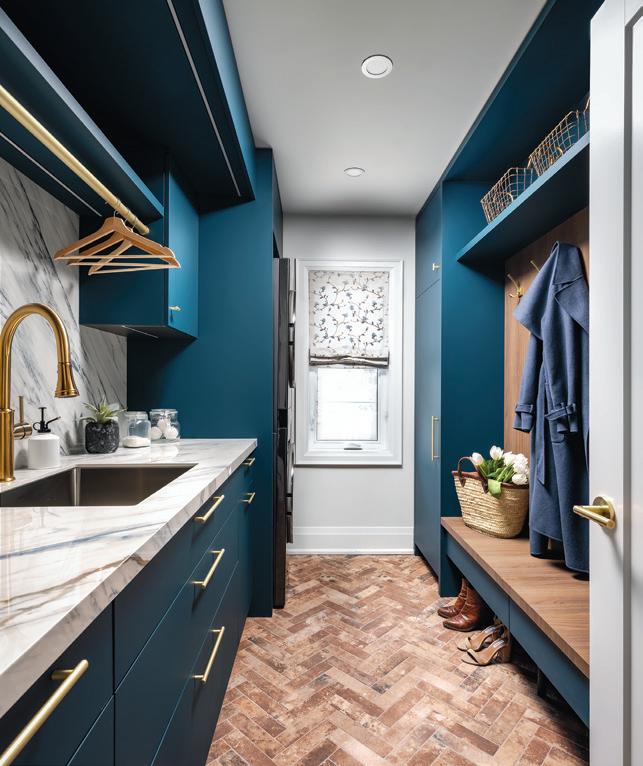
of marble without the maintenance requirements or higher cost. When budgets allow, extending the material behind the sink as a fullheight backsplash creates a clean, sophisticated finish.
Utility spaces are often among the smaller rooms in the home, so being creative in planning becomes vital. We look to the vertical to extend cabinetry and shelving to the ceiling providing extra storage for seasonal items that require only occasional access. As well, a built-in bench with a lift-up seat offers concealed storage alongside comfort and useability.
Beautifully designed laundry and mudrooms ensure that these high-function areas serve the family efficiently while harmonizing with the home’s overall style. These are much-used rooms deserving our attention and benefiting homeowners with comfort, organization and lasting enjoyment.
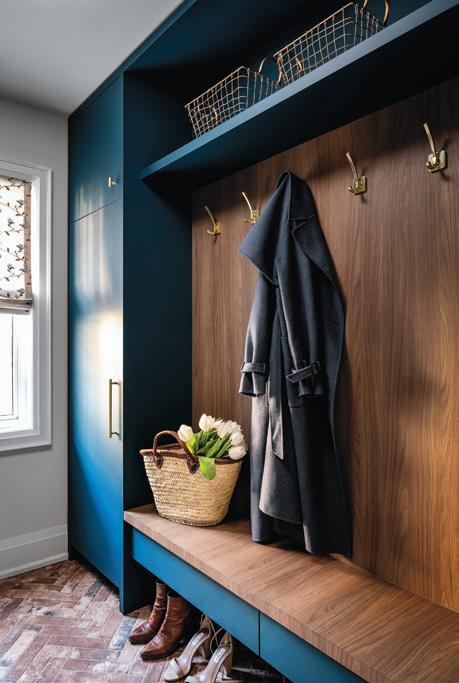
An award-winning in-house designer, Mariam Aboutaam is Director, Sales and Marketing, Interior Design at Kylemore, Markham, Ont., a builder known for masterplanned communities and luxury homes. kylemoreliving.com.
The
1. Bristol place 199 Main St, North, Brampton
2. Duo condos Malta ave & Steeles Ave
3. Mayfield Collection 2256 Mayfield Road. Mayfieldcollection.ca
4. Curio Condos 801 The Queensway marlinspring.com
5. Humberwood Heights 50 Humberwood Blvd. tributecommunities.com
6. Arcadia District Bloor & Kipling arcadiadistrict.com
7. Kül Condos 875 The Queensway kulcondos.com
8. Panda Markham 8200 Warden Ave. lifetimedevelopments.com
9. Gallery Towers at Downtown Markahm 162 Enterprise Blvd. downtownmarkham.ca
10. Highmount 4077 Hwy. 7 highmountbykingdom.com
MISSISSAUGA
11. Birch at Lakeview Village Lakeshore & Dixie Rd. branthaven.com
12. Artform Condos 86 Dundas St. E. emblemdevcorp.com
13. Exhale Condominiums Lakeshore Rd. East & Dixie Rd. exhalelakeshore.ca
14. Westport 28 Ann Street westportcondos.ca
NORTH YORK
15. Central Park Sheppard Ave. East & Leslie St. amexon.com
16. Yonge City Square 4050 Yonge St. yongecitysquare.com
PICKERING
17. Vupoint Kingston Rd. & Liverpool Rd. tributecommunities.com
OSHAWA
18. U.C. Tower 2425 Simcoe St N,Oshawa tributecommunities.com
TORONTO
19. Lawrence Hill Urban Towns Don Mills & Lawrence lawrencehillurbantowns. com
20. 489 Wellington St. W. 489 Wellington St. W. lifetimedevelopments.com
21. 500 Dupont St. 500 Dupont St. lifetimedevelopments.com
22. Artistry Condos 292 Dundas St. W. tributeartistrycondos.ca
23. Panda Condos Yonge & Dundas. lifetimedevelopments.com
24. 36 Eglinton Ave. W. 36 Eglinton Ave. W. lifetimedevelopments.com
25. Linx Condominiums Danforth & Main tributecommunicties.com
26. Y&S Condos 2161 Yonge St. tributecommunities.com
27. 50 at Wellesley Station
50 Wellesley St. East pureplaza.com
28. No. 1 Yorkville 1 Yorkville Ave. pureplaza.com
29. Theatre District Residences Adelaide & Widmer pureplaza.com
30. Bijou on Bloor 2450 Bloor St. West pureplaza.com
31. The Briar on Avenue 368 Briar Hill Ave. pureplaza.com
32. One Seventy Spadina & Queen St. West pureplaza.com
33. King West & Charlotte King St. West & Charlotte pureplaza.com
34. Forest Hill Private Residences
2 Forest Hill Rd. foresthillresidences.com
35. Oscar Residences 500 Dupont St. W. at Bathurst oscarresidences.com
36. Kingside Residences Kingston Rd. & Danforth altreedevelopments.com
37. Allure Condominiums 250 King St. East emblemdevcorp.com
38. XO Condos King & Dufferin lifetimedevelopments.com
39. 225 Jarvis Street Condos Dundas St. East & Jarvis amexon.com
40. 101 Spadina Spadina & Adelaide 101spadina.com
41. The Residences of Central Park Sheppard Ave. East & Leslie centralparktoronto.com
42. The Dawes at Main Street Danforth & Main St. thedawes.com
43. Birchaus Birchcliffe Village on Kingston Road birchausresidences.com
44. Knotting Hill 4000 Eglington Ave. W knottinghillcondominiums.com 45. 429Walmer Forest Hill Village 429walmer.ca
46. Park Avenue Place 1 & 2 Jane St. & Rutherford Rd. solmar.ca
The latest properties in the Southwestern Ontario Area to
1. Affinity Condos Plains Rd. E. & Filmandale Rd. rosehavenhomes.com
2. Millcroft Towns Appleby Line & Taywood Dr. branthavenmillcroft.com
3. North Shore North Shore Blvd. & Plains Rd. nationalhomes.com
FORT ERIE
4. Discoverie Condos Signature Communities discoveriecondos.ca
GUELPH
5. Gordon Square III Gordon St & Clair Rd E tricar.com
HAMILTON
6. The Design District 41 Wilson Street emblemdevcorp.com
7. Corktown 225 John Street South corktown.condos
8. Lusso Urban Towns Martindale Rd. & Grapeview Dr. lucchettahomes.com
OAKVILLE
9. The Greenwich Condos at Oakvillage Trafalgar Rd. & Dundas branthaven.com
10. Synergy McCraney St. E. & Sixth Line branthaven.com
11. Upper West Side at Oakvillage 351 Dundas St. E. upperwestsidecondos2.ca
12. Greenwich Condos at Oakvilage Trafalgar Rd. & Dundas St. branthaven.com
13. Villages of Oakpark Dundas & Trafalgar ballantryhomes.com
STONEY CREEK
14. Casa Di Torre 980 Queenston Rd. branthaven.com
15. On The Ridge Lormont Blvd. & Chaumont Drive liveontheridge.ca









